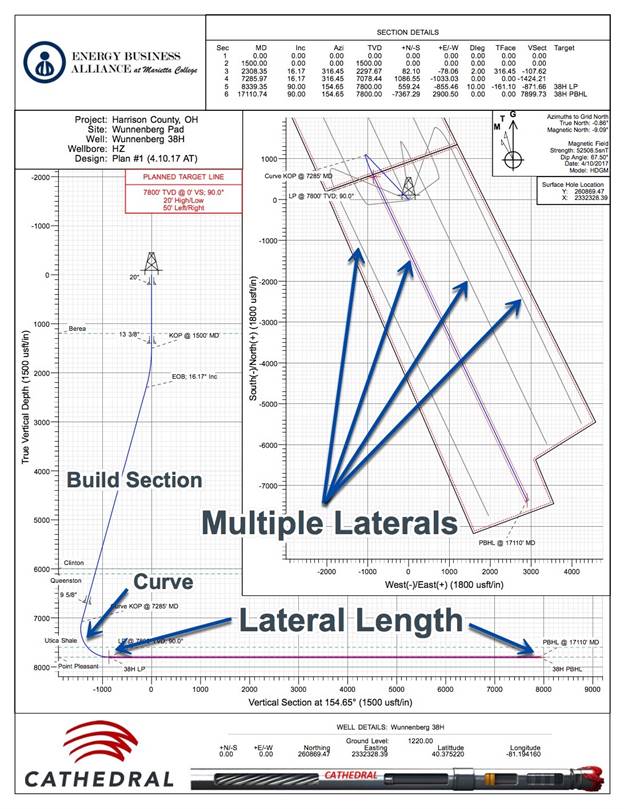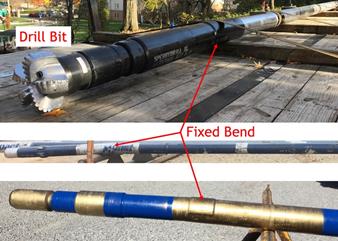
Sample directional plan prepared for Energy Business Alliance by Cathedral.
DIRECTIONAL DRILLING
Now that you are more familiar with the basics of drilling, let's talk about how the wells are drilled horizontally and why. It is important to realize that a vast majority of the new onshore wells being drilled today in the U.S. are horizontal wells. Thus, to get the well horizontal, directional drilling is utilized to influence the path of the wellbore. Directional drilling is not only used for oil and gas wells but is also used for utilities such as pipelines. For example, directional drilling is often used to install pipelines below roads or rivers. Furthermore, this technology can be utilized to intersect other wells in order to relieve a well that is uncontrollable at the surface. This is called a "relief well" and was done in the months following the BP Macondo blowout in the Gulf of Mexico in order to stop the leakage of oil and gas into the Gulf.
However, what we intend to focus on in this course is the directional drilling of oil and gas wells in order to create a horizontal wellbore as is commonly done nowadays. The benefits of drilling a horizontal well are many; however, they come at a greater cost. Having a horizontal wellbore through the formation allows for much greater formation contact, and thus should lead to much more production when compared to a well that just intersects the formation vertically. Another large benefit is that much less surface disturbance is created with horizontal wells. Multiple horizontal wells can be drilled from one pad and can produce more oil and gas compared to vertical wells. To get the same amount of production, multiple vertical wells would be required and each would need a new surface wellpad built. Thus, horizontal drilling allows for greater production at a much smaller surface footprint.
In order to discuss the basics of a horizontal well, let's refer to the sample directional plan below.
This sample shows a wellpad that has multiple horizontal wells planned. One of them is detailed on the left and bottom of the page. Let's focus on that one. In order to drill a well horizontally, directional tools must be used. You will learn more about these in the next section. For now, let's talk about method. Once the operator establishes where they want the lateral to start and end, the build section and curve section is planned accordingly.

Sample directional plan prepared for Energy Business Alliance by Cathedral.
Once the well is begun at the surface, it is drilled down until "kick-off point" is reached. This is where the build section will start. The purpose of the build section is to begin deviating the well further away from other nearby wells and create the step-out that is needed. To understand this need, let's look at the bird's-eye-view on the right side of the image above. This shows multiple laterals (the horizontal part of the well) that are planned to be drilled from the same wellpad. In other words, the laterals will be spaced approximately 1,000 feet apart in the formation (reservoir), but are only about 15-25 feet apart on the surface. Thus, step-outs are needed. This "steps" the well out to the side. On this particular design, you can also see that the well is being "stepped back." This is sometimes done to capture more of the available reservoir.
After drilling the build section, it is then time to begin the "curve." The point of the curve is to connect the build section to where the lateral will begin (also known as the "landing point"). This often involves a much sharper "curve." The steepness of the curve depends on the tools that are being used and the preference of the operator. Once the curve is completed and the lateral is begun, the remainder of the lateral is drilled. The lateral is usually very close to horizontal, but usually not an exact 90 degrees. This is because formations are normally dipped to one side, thus when the lateral is complete, the end of it (called the "toe") will usually either be pointed up slightly or down slightly. This is referred to as "toe-up" or "toe-down."
If you wish to learn more about how this is done, check out the “technique” section below.
So now that we understand the application and planning of directional drilling, let's examine how it is done.
Today, there are mainly two ways in which directional drilling is completed- by "sliding" or by utilizing "rotary-steerable" systems. Both are still widely utilized, but rotary-steerable systems are newer. Many factors go into a company's decision of which one to use, and sometimes both systems are used on the same well. Below is the basic breakdown of how they work.

Figure 1. Three Examples of a Fixed Bend Directional Assembly. This would be used for the "sliding" technique of directional drilling.
Neither technology, however, would be accurate without the use of measurement while drilling (MWD) tools. These tools are housed above the bit and directional tools which take measurements such as inclination and azimuth through the use of gyroscopes, magnetometers, and accelerometers. Those measurements are then transmitted up to the surface drilling location through either electromagnetic (EM) waves or by pulsing the mud. If done through mud pulses, think of it like Morse Code. Either method can allow for communication from the bit to the surface and from the surface to the bit. This technology allows drillers to know within a small margin-of-error where their wellbore is.